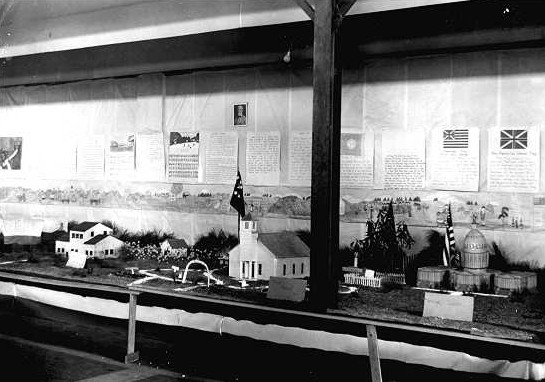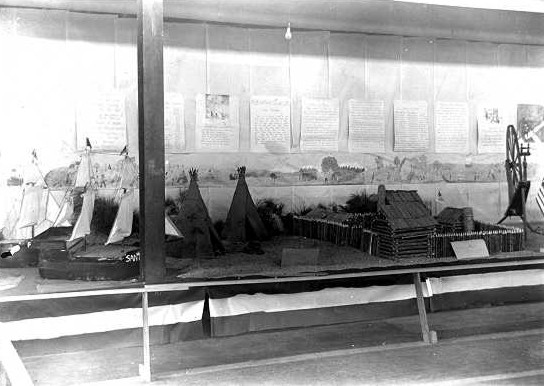COUNTY FAIR WAS ALWAYS A BIG EVENT
Brenda Kirk Fiddler
October 5, 1994
Lexington Progress
Since 1902 the people of Lexington and Henderson County have been having fun at the fair. That was the year merchants of Lexington, seeking to drum up business, first arranged for a carnival "outfit" to set up around the new courthouse for two days. The shows and rides attracted a goodly number of the 18,000 residents of the county. The fair has had several inactive periods, but this early start demonstrated the same spark of community interest that now marks the fair every year.
In 1903, the fair board committee members H. E. Graper, W. V. Barry, W. L. Stegall, D. L. Wadley and O. K. Murray, planned a three-day fair in October which would "...exceed all expectations with a thousand dollars of merchandise and cash given away." The Progress coverage praised every aspect, "The second effort of the business men and other citizens of Lexington in the direction of the street show has passed into the history attended by as full a measure of success as the most sanguine could have hoped. The National Amusement Company employed by the local committee opened for business on the 14th with a considerable crowd on account of Circuit Court being in session. On Thursday the home part of the street show began with the exhibition of farm products, fruits, stock and poultry. Friday the crowd was enormous and the Carnival Company's attractions were enjoyed to the fullest. The good nature and sobriety of the crowd was a matter of general comment." (The sale of whiskey was put out in 1901.)
Amazing feats were performed by Oscoe the Snake Eater and Prof. Wing, a high diver, who somersaulted from a 35-foot ladder. Crowds of up to 300 per show praised the fine voices of the singers performing in the "Old Plantation Minstrel Show."
The contest conducted by the merchants served several purposes — to generate enthusiasm for the fair, to get customers into the stores, and, in some cases, to provide monetary help for people in need. The Progress described the selection of contest winners by the crowds. "The stores were opened up for vigorous balloting in the many contests, which were continued for two days." J. R. Fielder, proprietor of a dry goods store located in what is the vicinity of Lexington First Federal, offered a five dollar pair of Florsheim shoes to the farmer hauling the largest number of women in a wagon to his store. Some confusion resulted in the tally and Fielder, promoting his business as "the home of good shoes," generously gave a pair each to K S. Bird and John Hatchett, who hauled 56 and 67 women. (Some confusion still exists — would 67 women fit in a wagon, or was the count based on several loads? Anyway, Molly Knowles was voted as the most popular woman in a wagon.
In C.F. McHaney Drugstore, Miss Maggie Neisler won the prize for be-big the most popular school teacher. Stewart Drugstore awarded prizes to Tom Bird (age 87), chosen as the oldest man, and Dr. G.W. Fesmire, the most popular physician. Other winners included Mrs. Mary Ann Rhodes-oldest woman (96 years); Mrs. Mary Ann Rhodes-longest habitual smoker, smoker for 80 years; Myrtle Gilliam-prettiest young lady; Ollie Walker-sweetest girl under 10; Bertha Ballard-sweetest girl 10 to 15; Cade Stanford-most popular fireman; Steve Goff-most popular young man; T. E. Sellers-most popular man over 60; B. T. Flake-father of finest baby; Robert Long-winner of footrace for men over 60; Rock Maness-winner of slow mule race; Mrs. J. T. Stanford and Mrs. Henry Wilson-best lady horseback riders; Dr. R. L. Smith-best gentleman rider; and W. H. Pugh, Bargerton-most popular merchant in the county. Prizes were also awarded for largest woman (winner was 259 pounds) and "the ugliest man
Chosen as "the most popular widow in each civil district earning her own support" were Mrs. P. Scott-4th; Mrs. Dave Knowles-6th; Mrs. Annie Ballard-7th; Mrs. Phelps-9th; Mrs. L. Jowers10th; Mrs. E. Wadley-l1th; Mrs. Nola Hancock-15th; Mrs. M. A. Adams-l7th; and Mrs. L. A. Azbill-20th. Mrs. Nancy Jacobs was named the most deserving widow in Lexington, Mrs. Sallie McNatt-most deserving widow in Lexington, Mrs. Sallie McNatt-most deserving widow (in county?), and Mrs. Ellen Lewis was named as the widow bringing the most children. Ollie Graves was named the most popular orphan girl.
Exhibition winners included M. Jones-wheat; Billy Bailey-pumpkins and sorghum; Mrs. Martin Hare-honey; Mrs. G.H. Griggs-dried apples; J.R. Anderson-tobacco; G.H. Buck-vinegar; and Emily Stanford-rag carpet. Winning for best potatoes was Mrs. W.J. Cox. (Earlier, in July Mr. Cox had advertised for sale a home place on the north side of Lexington: new house with four rooms and hail, fine water, two acres ground, stable, garden, strawberry patch, fine orchard with 120 bearing trees. Asking price — $300 cash.)
In October 1905, Lexington's street fair and carnival featured a balloon ascension. The merchants offered cash prizes to: the oldest man and woman going into W.W. Sweatt's store; the shortest man over 25 years old going into G.W. Florence's store; the tallest man that ate in A. Henry's restaurant; and the prettiest baby at Pruitt Millinery Co. Prizes were given to fairgoers taking to certain stores, the best sheep, harness horse, saddle horse, the largest pumpkin, the heaviest chicken and the largest hog.
Students accustomed to swinging from grapevine over a gully or creek for fun thrilled to the breathtaking rides on the Ferris Wheel and flying jenny. Attempts to duplicate the rides were not uncommon, and in fact, one such attempt led to a tragic accident in 1913 at Beech River School. Loyes Watson, age 11, was killed "by the lever or revolving beam of a primitive ‘flying jenny' falling on his chest and crushing him so severely that he died in about thirty minutes." Several lads were constructing the ride during recess unknown to the teacher, Mr. V. N. Blankenship. The funeral and burial at Beech River Cemetery were attended by a large crowd of sympathizing relatives and friends." (Progress, Feb. 7, 1913)
The big attraction for the 1913 fair was a circus of almost one hundred performers and a wild beast exhibit arriving by a special train. The Big Top was pitched on the show grounds located on Jackson Street near the Daws Hotel (location of post office). The hotel, damaged in the spring of 1913 by the tornado, had undergone extensive repair and enlarged with a two-story wing of seven bedrooms, a "toilet room" and a dining room. G.H. Daws had purchased the hotel formerly known as the Scott House in 1906. The success of Mr. Daws in his hotel business was "largely attributable to the indefatigable work of his excellent wife," according to one source.
In 1913, immediately after the week-long fair, Mr. Barry, vigorously campaigned for ten-dollar contributions from 200 men to insure that a county fair could be held the next year. A show of public support was needed. Some opposition had arisen because of "too many fake shows and gambling schemes." The many entries in the agricultural exhibition had resulted in displays having to be set up in courthouse offices. A permanent fairground area was highly desirable.
In the early years, much of the success of the fair depended, as it does now, on the work of the fair board, support of the merchants and the attendance of the school children. In 1906, The Progress editorialized, ."A street fair by all means. We favor the town giving it for the benefit of the school." Under construction at the time was the "New College" at a cost of $6,000. Joe L. Hearn was the contractor.
By 1915, school floats had been added to the street parade. In 1924, prizes were given to schools having the greatest percentage of their enrollment marching in the parade. All but one of Alberton's sixty-five students marched, and all but three of Russell's Crossroads' 122 students marched, making the two schools' the winners. Other schools having high participation were Independence, Sandy, Mable Grove, Central, Long Sought and Poplar Springs. By actual count, 1,800 students participated. Since cotton picking was going on with a good yield (10,961 bales up from 7,088 in 1923), the students, who no doubt picked cotton for fair money, could afford the 5-cent hamburgers.
By 1936, the fair featured school exhibits. In 1940, Miss Louise Oakley, Supervisor of Henderson County Schools, decided that all 55 schools would cooperate in a historical project. The seventy-two foot display, set up in the city school gym, was made up of history reports written by students about their respective communities in the summer of 1940. The students interviewed senior citizens pertaining to the first settlers, names and locations of the churches, stores, post offices, mail carriers, and the oldest homes. The history focused on the buildings serving as school houses, their locations, and teachers. Each school's teacher compiled the information using the outline provided by Miss Oakley. Now, more than 50 years later, the oral history gathered and recorded by grammar school children, compiled in a booklet, titled "History: Henderson County Schools," and displayed by Miss Oakley for the Henderson County Fair, is one of our most valuable sources for local history. Total cost of the project: $40.00.
The food and the fun, the biggest and the best, the oldest and the youngest, the unusual and the fairest — all of these things have made the fair a popular event in Lexington and Henderson County for almost a century, but the real attraction is knowing that the fair is an experience we can keep on sharing.

At the 1940 Henderson County Fair, students from the county's 55 schools
cooperated on a historical
project for display. The 72 foot display was set up in the city school gym and
was made up of history
reports written by students about their communities. Now, more than 50 years
later, the oral history
gathered and recorded by grammar school children is one of our most valuable
resources for local
history Total cost of the project: $40. (Photo courtesy of Miss Louise
Oakley.)

By 1936, the Henderson County Fair featured school exhibits, such as the one
pictured. Miss Louise
Oakley, Henderson County Schools Supervisor, coordinated a historical project
in which all 55 schools
in the county participated. The project contained history reports written by
students about their
respective communities in the summer of 1940. (Photo courtesy of Miss Louise
Oakley.)
